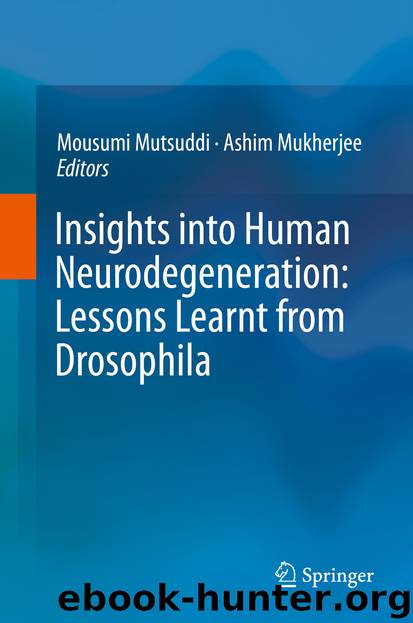Insights into Human Neurodegeneration: Lessons Learnt from Drosophila by Mousumi Mutsuddi & Ashim Mukherjee

Author:Mousumi Mutsuddi & Ashim Mukherjee
Language: eng
Format: epub
ISBN: 9789811322181
Publisher: Springer Singapore
Insights of Tau Pathology from Drosophila Models
The limitations associated with human genetics call for the use of model organisms to investigate in depth the mechanistics of disease pathogenesis and to develop effective treatment strategies. Model organisms such as mice, Drosophila and C. elegans have been utilized to investigate the cellular and molecular mechanisms of the pathogenesis of human neurodegenerative disorders like tauopathies, poly(Q) disorders, etc. Subsequently, Drosophila emerged as a model of choice to investigate in-depth human tau pathology at the cellular and molecular levels. One of the most worthwhile utilizations of Drosophila disease models is the screening of genetic modifiers, which aim to identify second-site locus that either suppresses or enhances the disease effect.
Human tauopathies such as Alzheimer’s, Parkinson’s, frontotemporal dementia, etc. have been successfully modelled in Drosophila by expressing wild-type or mutant isoform(s) of human tau (Chanu and Sarkar 2017; Wittmann et al. 2001; Gistelinck et al. 2012; Trotter et al. 2017). Intriguingly, Drosophila tauopathy models duplicate the features of human neurodegenerative diseases such as degeneration of brain cells, progressive locomotor defects, cognitive impairments and reduced life span (Sarkar 2018; Sivanantharajah et al. 2019). Flexible genetic tools such as the UAS-Gal4/Gal80 system allow the expression of a disease-causing transgene in a tissue- and a developmental time-specific manner (Chanu and Sarkar 2017; Wittmann et al. 2001; Trotter et al. 2017). In addition, expression of the disease-causing transgene in adult eyes drives easily the scorable-specific phenotype. For instance, expression of V337M human tau in the fly eyes gives a rough eye phenotype, which can be utilized to screen modifiers at a large scale within a short period of time (Shulman and Feany 2003). Similarly, targeted expression of human tau in brain or mushroom body causes degeneration of brain cells and results in locomotor and cognitive impairments (Kosmidis et al. 2010). By utilizing the fly system, it was noted that tau facilitates neurodegeneration by promoting global chromatin relaxation, and such heterochromatin loss has been proposed to act as a toxic effector of tau-mediated neurodegeneration (Frost et al. 2014). Interestingly, a positive correlation between the extent of neurodegeneration and the toxicity level of the various mutant human tau isoforms suggests a similarity between the disease pathogenic mechanisms in human and Drosophila (Chanu and Sarkar 2017; Wittmann et al. 2001).
It was demonstrated in fly models of tauopathies that the phosphorylation status of the tau protein increases at some specific sites, that is, AT8 and AT100 positions in an age-dependent manner, which, in turn, causes increased tau insolubility and glial tangle formation and degeneration of neuronal and dendritic cells (Colodner and Feany 2010; Lin et al. 2010). As noted earlier, fly disease models have extensively been utilized for genetic modifier screening. Extensive genetic screening performed in different laboratories has identified several serine/threonine kinases, phosphatases and the components of the cytoskeleton network as the major classes of modifiers of human neuronal tauopathies (Shulman and Feany 2003; Blard et al. 2007; Ambegaokar and Jackson 2011). By utilizing this approach, a Drosophila homolog of GSK-3β, shaggy, was found to modulate the tau-mediated neurodegeneration in fly models.
Download
This site does not store any files on its server. We only index and link to content provided by other sites. Please contact the content providers to delete copyright contents if any and email us, we'll remove relevant links or contents immediately.
| Automotive | Engineering |
| Transportation |
Whiskies Galore by Ian Buxton(41879)
Introduction to Aircraft Design (Cambridge Aerospace Series) by John P. Fielding(33064)
Small Unmanned Fixed-wing Aircraft Design by Andrew J. Keane Andras Sobester James P. Scanlan & András Sóbester & James P. Scanlan(32743)
Craft Beer for the Homebrewer by Michael Agnew(18140)
Turbulence by E. J. Noyes(7936)
The Complete Stick Figure Physics Tutorials by Allen Sarah(7307)
Kaplan MCAT General Chemistry Review by Kaplan(6867)
The Thirst by Nesbo Jo(6826)
Bad Blood by John Carreyrou(6552)
Modelling of Convective Heat and Mass Transfer in Rotating Flows by Igor V. Shevchuk(6391)
Learning SQL by Alan Beaulieu(6211)
Weapons of Math Destruction by Cathy O'Neil(6143)
Man-made Catastrophes and Risk Information Concealment by Dmitry Chernov & Didier Sornette(5921)
Digital Minimalism by Cal Newport;(5664)
Life 3.0: Being Human in the Age of Artificial Intelligence by Tegmark Max(5474)
iGen by Jean M. Twenge(5366)
Secrets of Antigravity Propulsion: Tesla, UFOs, and Classified Aerospace Technology by Ph.D. Paul A. Laviolette(5309)
Design of Trajectory Optimization Approach for Space Maneuver Vehicle Skip Entry Problems by Runqi Chai & Al Savvaris & Antonios Tsourdos & Senchun Chai(5011)
Pale Blue Dot by Carl Sagan(4912)
